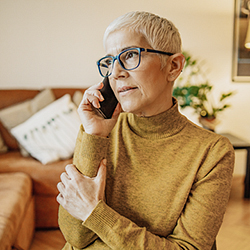
If there’s one thing that Dr. Folashade Ajegba wants women who get a callback after a screening mammogram to know it’s this: don’t panic.
A breast imaging and interventional radiologist with Radiology at Baystate Health, Ajegba says that the majority of callbacks end up being nothing of concern. “Sometimes, the image just isn’t clear, or it doesn’t show all the breast tissue. In other cases, we may see an area that looks different than other parts of the breast or a previous exam. The difference could be the result of the breast not being as compressed as the last time or positioned differently. But out of an abundance of caution, we like to ask patients to come back in so we can do another round of imaging, referred to as a diagnostic mammogram. Again,” she emphasizes, “in the large majority of cases, there is no reason for concern.”
What are the Most Common Reasons for Being Called Back for a Mammogram?
As Ajegba notes, most callbacks aren't due to seeing cancer on the imaging. The most common reasons for getting a mammogram callback are:
- unclear image
- image doesn't show all the breast tissue
- something looks different from a previous exam
- something looks different from another part of the breast
- the breast was compressed differently or in a different position than previous imaging, making it difficult to see changes
- abundance of caution – reviewing any anomalies on the imaging and conducting follow-up tests as needed
Breast cancer is extremely treatable and survivable, and the best results are if it is caught early. This is why callback mammograms are so important—to rule out any concern, however small, that something on the image could be serious. Most of the time, Ajegba notes, there is no reason for concern.
What to Expect at a Callback Mammogram
For most patients, a callback mammogram—or diagnostic mammogram—isn’t that different from the initial screening mammogram.
“A diagnostic mammogram is done just like a screening mammogram,” says Ajegba, “but more pictures are taken of the area in question so that it can be looked at more closely. Another difference is that there is a radiologist on hand to make sure that all the needed images are taken.”
Ajegba notes that some patients may also undergo a breast ultrasound, which is completely painless.
Patients who have a diagnostic mammogram performed at the Baystate Breast and Wellness Center often receive the results of their imaging before they leave the office.
What Happens After a Callback Mammogram?
For the majority of women receiving a diagnostic mammogram, the procedure confirms that the image was clear and there is nothing to be concerned about.
In some cases, it may be recommended that a patient has their next imaging test sooner than normal—say six months versus a year. “This,” says Ajegba, “is to make sure that the area in question doesn’t change over time.”
In a small percentage of cases, a biopsy may be recommended to rule out any cancer.
“If the second round of imaging reveals a mass or a lesion, a biopsy is the next best step to determine if it’s harmless—benign— or not,” says Ajegba.
Scheduled as a separate procedure, a biopsy involves removing a very small piece of the tissue in question and examining it for cancer. Depending on where the tissue in question is located and the nature of its appearance, your biopsy may be performed using a small, hollow needle or may necessitate making a small incision in the breast.
Ajegba notes that results of most biopsies are benign. “A biopsy is just another measure to prove to the providers that what they’re seeing in the images is not cancer.”
Overcoming Callback Mammogram Anxiety
As alarming as getting a diagnostic mammogram or even a biopsy sounds, they are essential tools for monitoring your breast health and staying ahead of any issues that may arise.
“While it’s completely natural to become anxious waiting for appointments or test results,” says Ajegba, “it’s a good idea to try and keep your emotions in check. Again, most breast changes picked up on screening mammograms are not life-threatening or even cancer. If you have a friend or family member who has had these procedures, you may find it helpful to speak with them about their experience. Or you may just wish to talk about the feelings you’re having with a friend or a counselor. If you’re uncertain who to turn to, you can call the American Cancer Society at 1-800-227-2345 to be connected with someone who can answer any questions you might have and lend support.
The most important thing is to not let your anxiety keep you from scheduling a diagnostic screening. Simply put, mammography is your most powerful tool for detecting breast cancer early, when it’s easiest to treat.
If you have questions or concerns related to your breast health, contact Baystate Breast & Wellness Center at 413-794-8899.